 Epidemic, crisis; these words are splattered across social media feeds, newspapers, blogs, and our television screens. The opioid addiction problem in our country is front and center. Families of overdose victims are holding rallies; lawmakers are discussing prevention measures in forums every day. What was once an inner-city issue, has now spread to rural and suburban communities, grabbing hold of every American demographic.
Epidemic, crisis; these words are splattered across social media feeds, newspapers, blogs, and our television screens. The opioid addiction problem in our country is front and center. Families of overdose victims are holding rallies; lawmakers are discussing prevention measures in forums every day. What was once an inner-city issue, has now spread to rural and suburban communities, grabbing hold of every American demographic.
The disease of drug addiction is not cut and dry; black or white. You’ll hear politicians argue the same point. That being said, it appears we have another growing trend taking place; that is, the treatment for opioid addiction. Due to the crisis being as it may, with more than 33,000 dying of opioid-related overdoses in 2015, treatment has manifested into a game of medicate first and educate second. As the numbers skyrocket and stories of death become a norm, those in power scramble to find solutions. Those solutions have included Naloxone, the overdose reversal drug, medication-assisted treatment, and most recently as last week, safe-injection sites in Seattle…the first in our country.
What is wrong with this picture? Why is the first line of defense, the “go-to”, always medication…or now, legal use of heroin? Making Naloxone more readily available to the public is most definitely one of the best initiatives thus far. Nevertheless, what happens after Naloxone? Are these individuals being referred to treatment? Or, are they given the antidote and sent on their way? With regard to medication-assisted treatment, we are not presuming that it has zero chance of being beneficial for a variety of individuals, but to assume it will be favorable for every opiate addict seeking help is foolish…and dangerous. Once again, if medications worked in the treatment of addiction, they would have by now, with the use of Methadone or Antabuse.
Consider this scenario. Joshua is a young opiate addict, who was originally prescribed Vicodin for a sports injury in high school. Quickly, Joshua graduated from Vicodin to buying OxyContin illegally, a drug much more potent. After 2 years of abusing opiate medication, he made the decision to ask for help. With no former education on recovery or experience with the treatment process, he entered his first addiction rehab. After his completion of rehab, Josh was referred to an outpatient program, where his clinician recommended a medication to couple his therapeutic sessions. With little understanding of opioid addiction treatment medications, Josh complied with his counselor, seeing as she was the professional.
In Josh ua’s eyes, Suboxone became a cure for his OxyContin addiction. He stopped going to meetings and didn’t see much of a point in continuing therapy. Before Josh knew it, he found himself in a place all too familiar. Dependent upon a chemical and overcome with obsessive thinking. It was like using all over again, except without the intense high he felt from Oxys. Eventually, Joshua told himself that if he was going to be this miserable, he might as well be taking the substance he really wanted. Back to OxyContin he went.
ua’s eyes, Suboxone became a cure for his OxyContin addiction. He stopped going to meetings and didn’t see much of a point in continuing therapy. Before Josh knew it, he found himself in a place all too familiar. Dependent upon a chemical and overcome with obsessive thinking. It was like using all over again, except without the intense high he felt from Oxys. Eventually, Joshua told himself that if he was going to be this miserable, he might as well be taking the substance he really wanted. Back to OxyContin he went.
What Are The Qualifications?
Why is it that we would rather medicate first and ask questions later? Yes, medication-assisted treatment programs can be a useful tool, but that is all dependent upon the person and situation. Say for instance you have an individual who has struggled with opioid addiction for many years and has attempted treatment and recovery several times without success. This may be a person who should be considered for such a program, especially considering the staggering number of deaths. Nevertheless, if this means of programming is the decided option for this user, there should still be intensive treatment involved in their case, along with an end goal in sight. Prolonged use of drugs such as Suboxone, will only further physical dependence.
While the term is medication-assisted treatment, the treatment portion is often forgotten about or pushed as a secondary priority. This is where many people fail on maintenance programs. Without the necessary clinical interventions taking place, along with integration into the recovering communities, the user’s underlying issues, mental obsessions, and spiritual maladies are not addressed. Typically, these are the main culprits for the onset of addiction.
With that being said, a young person such as Joshua, who has never been given a chance to experience abstinence and a 12-step model of treatment, should not qualify for medications right off the bat. When we do this, we are inevitably telling our young users that they cannot achieve sobriety without some form of crutch; we are implying that recovery, especially the early stages of it, are merely impossible to overcome. That is simply not the case! Recovery has been possible for millions of people; otherwise, fellowships such as Alcoholics Anonymous and Narcotics Anonymous would not be as strong and as prevalent as they are in today’s society.
Another Generation Of Opioid Addiction
Rather than spending the time and funds on education for opioid addiction, therapeutic settings, and community resources, our society has found an easy way out. Yes, medication may keep the death toll down, but where does that leave these individuals in 6 months, a year, or many years to come? Inevitably, these users will need to come off of those medications, and may have a difficult time doing so alone.
Often times, Methadone and Suboxone withdrawal is a very uncomfortable process and needs to be treated by medical and addictions professionals. The symptoms of withdrawal mirror those of a heroin detox. So what does that tell us? We are just delaying the inevitable. Is it possible, that with the use of medication-assisted treatment, we are creating another generation of addicts that may have gotten it the first time with an abstinence-based model? How will we ever know, unless we give them an opportunity to try?
Clearbrook’s Opioid Addiction Treatment Program
For more than 4 decades,our addiction treatment center in Pennsylvania has been a leader in quality treatment, especially in regards to opioid addiction. Many of times, we have had patients come to us needing help to get off of a prolonged maintenance program. While their detox experiences varied, many shared similar stories in terms of how they began on said programs. Often times, they were promised a life free from addiction, but instead found more of the same.
If you or someone you love is struggling with addiction, or have found yourself addicted to a medication such as Suboxone or Methadone, we can help you. For more information, please contact our Admissions Specialists today.








